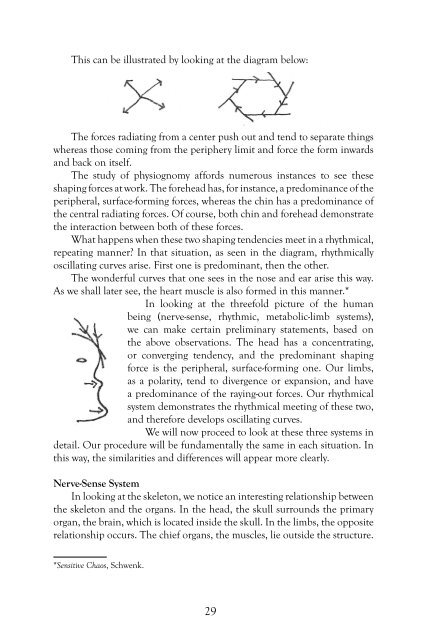When Healing Becomes Educating, Vol. 1 - Waldorf Research Institute
When Healing Becomes Educating, Vol. 1 - Waldorf Research Institute
When Healing Becomes Educating, Vol. 1 - Waldorf Research Institute
You also want an ePaper? Increase the reach of your titles
YUMPU automatically turns print PDFs into web optimized ePapers that Google loves.
This can be illustrated by looking at the diagram below:<br />
The forces radiating from a center push out and tend to separate things<br />
whereas those coming from the periphery limit and force the form inwards<br />
and back on itself.<br />
The study of physiognomy affords numerous instances to see these<br />
shaping forces at work. The forehead has, for instance, a predominance of the<br />
peripheral, surface-forming forces, whereas the chin has a predominance of<br />
the central radiating forces. Of course, both chin and forehead demonstrate<br />
the interaction between both of these forces.<br />
What happens when these two shaping tendencies meet in a rhythmical,<br />
repeating manner? In that situation, as seen in the diagram, rhythmically<br />
oscillating curves arise. First one is predominant, then the other.<br />
The wonderful curves that one sees in the nose and ear arise this way.<br />
As we shall later see, the heart muscle is also formed in this manner.*<br />
In looking at the threefold picture of the human<br />
being (nerve-sense, rhythmic, metabolic-limb systems),<br />
we can make certain preliminary statements, based on<br />
the above observations. The head has a concentrating,<br />
or converging tendency, and the predominant shaping<br />
force is the peripheral, surface-forming one. Our limbs,<br />
as a polarity, tend to divergence or expansion, and have<br />
a predominance of the raying-out forces. Our rhythmical<br />
system demonstrates the rhythmical meeting of these two,<br />
and therefore develops oscillating curves.<br />
We will now proceed to look at these three systems in<br />
detail. Our proce dure will be fundamentally the same in each situation. In<br />
this way, the similarities and differences will appear more clearly.<br />
Nerve-Sense System<br />
In looking at the skeleton, we notice an interesting relationship between<br />
the skeleton and the organs. In the head, the skull surrounds the primary<br />
organ, the brain, which is located inside the skull. In the limbs, the opposite<br />
relationship occurs. The chief organs, the muscles, lie outside the structure.<br />
*Sensitive Chaos, Schwenk.<br />
29

















